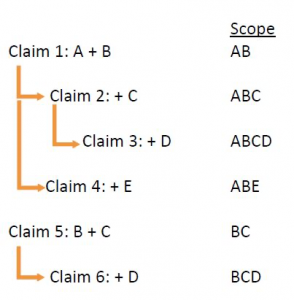
What are Dependent Claims?
A claim may be either independent or dependent in nature. When a claim is said to be independent, it means that it is a stand-alone claim containing all the limitations necessary to define an invention. However, when a claim is dependent in nature, it means that it refers to a previous claim and adds further limitations to the previous claim. It shall be understood that a dependent claim will always limit the scope. If it broadens the scope, it shall be construed as being improper and may face rejection by the examiner.

Why Draft Dependent Claims in a Patent Application?
The preliminary goal while drafting the Patent Application claims is to define an invention as broadly as possible to encompass the greatest scope of protection around the subject invention. This broad protection is often sought within the independent claims, and then it is gradually narrowed, thereby further defining the scope of the invention and claiming potential designs around by third parties, competitors, and infringers.
Furthermore, there is a significant cost benefit in strategically optimizing dependent claims when drafting a patent application. For instance, you may file up to 03 independent claims and 20 claims in total (dependent and independent) without incurring additional government fees by the USPTO. Thus, a majority of patent applications will have 01 to 03 independent claims and 17 to 19 dependent claims for a total of 20 claims if they better describe the invention without bearing any additional capital.
What is a Multiple Dependent Claim?
Multiple dependent claims depend on more than one previous claim and elaborate and add more to each previous claim on which they depend. Most of the jurisdictions that allow multiple dependent claims do not allow a multiple dependent claim to further depend on other multiple dependent claims. These are termed multiple-multiple dependent claims. Until March 2022, Japan permitted multiple-multiple dependent claims. However, now the practice has been discontinued. Therefore, it is necessary to check the requirements of each law before penning down the claims.
Consider the following as an example for a multiple dependent claim:
Claim 1: A recliner with a seat, legs attached to the seat, and a backrest attached to the seat.
Claim 2: The recliner of Claim 1, where there are four foundation legs.
Claim 3: The recliner of Claim 1 or Claim 2, wherein the four legs are parallel to one another.
Claim 4: The recliner of Claim 1 or Claim 2, wherein the seat comprises a top cushion surface with vibrating instruments.
Claim 5: The recliner of Claim 1 or Claim 2 wherein the back consists of the cushioned backrest with jade-roller blades.
Hereinabove, Claims 3, 4, and 5 are multiple dependent claims in nature.
The Upside & Downside of Drafting a Multiple Dependent Claim
A major advantage of the multiple dependent claim drafting format is that it creates more permutations of the invention. It safeguards the invention more elaborately by introducing combinations of elements. The same also acts as a solid defense mechanism against infringers who may, otherwise, in the absence of such multiple dependent claims, find their way to access the patented invention.
However, even though it may have its added advantages, it can be confusing and mindboggling to a certain extent. Therefore, many jurisdictions like the United States of America have introduced an extended fee to discourage such claims. Korea also prevents the drafting of multiple-multiple dependent claims since it induces ambiguity.
Drafting Tips for Multiple Dependent Claims
Proper Drafting of Multiple Claims
While drafting, it should be a priority consideration not to draft a multiple dependent claim depending on another multiple dependent claim. The example we took earlier of the recliner is a good prototype since multiple dependent claims do not depend on other multiple dependent claims.
Furthermore, the wordings have to be appropriate for them to be acceptable by the examiner. This condition requires that multiple dependent claims refer back to the alternative only.
A few examples of acceptable language would include:
- According to claims 4 or 5…
- According to any one of the preceding claims…
- According to any of the preceding claims…
- According to any of claims 2-5 or 7-9…
Improperly worded multiple dependent claims would look like this:
- According to claims 3 and 4…
- According to claims 5-7…
- According to the preceding claims…
- As in claims 3, 4, and/or 5…
Concluding Remarks
Therefore, it is crucial to remember the following:
- In Patent Drafting, claiming less is more. It is pertinent to draft a patent meticulously and not include everything that holds. Instead, have an independent claim that covers all the features and elements and narrows its scope down to dependent claims, and only, if and when required, draft multiple dependent claims.
- Pay attention to the language and format of the draft. Ensure assessing the acceptable language and formatting adopted in a jurisdiction to avoid rejection due to trifle issues.
- Focusing well on the fee details is a must (as mentioned earlier) since certain jurisdictions impose additional fees for filing multiple dependent claims.
- Also, make timely amendments as per the suggestions and recommendations of the respective Patent Office to avoid additional fees and delay in the process.

